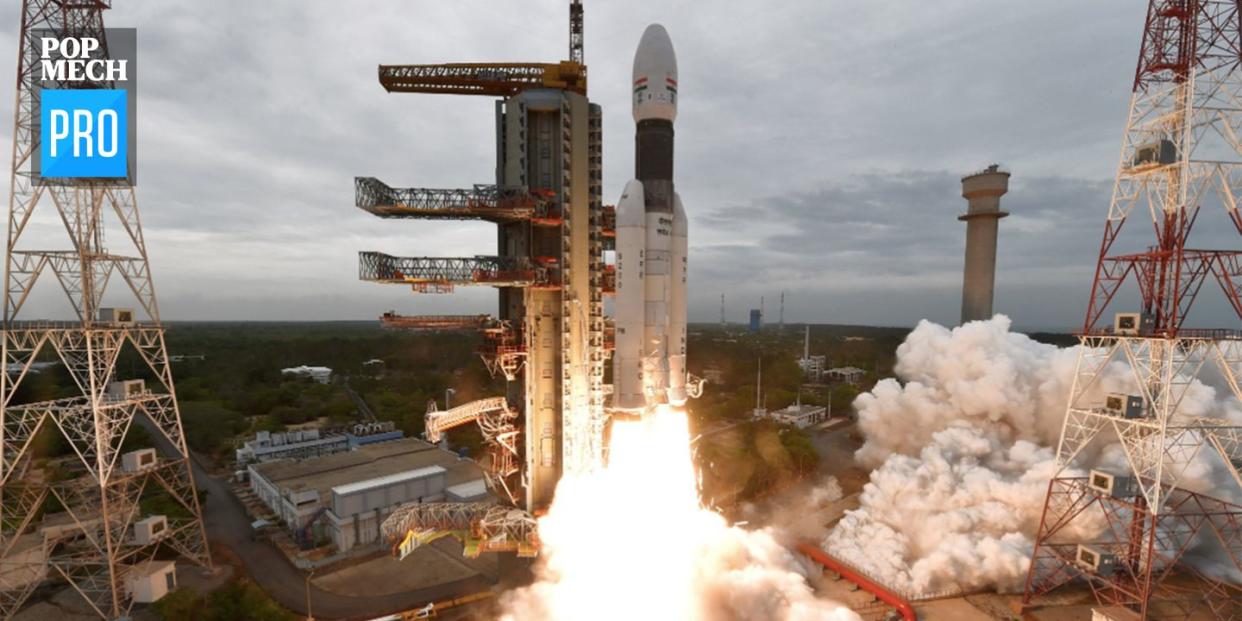India Is Headed to the Moon

India has successfully launched its second lunar mission, Chandrayaan-2. The country hopes that the launch will make bring it into the exclusive club of nations that have successfully made a soft landing on lunar soil.
Riding on an Indian-built rocket known as a Geosynchronous Satellite Launch Vehicle, or GSLV MkIII-M1, the successful launch from the Second Launch Pad at the Satish Dhawan Space Center, located on a small island off India's southeastern coast, took place at 2:43 pm Indian Standard Time (IST).
#ISRO
Here's a view of the majestic lift-off of #GSLVMkIII-M1 carrying #Chandrayaan2 pic.twitter.com/z1ZTrSnAfH— ISRO (@isro) July 22, 2019
#GSLVMkIII-M1 successfully injects #Chandrayaan2 spacecraft into Earth Orbit
Here's the view of #Chandrayaan2 separation#ISRO pic.twitter.com/GG3oDIxduG— ISRO (@isro) July 22, 2019
"Today is a historical day for Space Science and Technology in India. I am extremely happy to announce that GSLV MkIII-M1 successfully injected Chandrayaan-2 into an orbit of 6000 Km more than the intended orbit and is better," said Dr. Kailasavadivoo Sivan, head of the India Space Research Organization (ISRO), in a press statement.
The launch wasn't entirely smooth.
“Today is the beginning of the historical journey of India towards Moon and to land at a place near south pole to carry out scientific experiments to explore the unexplored. On July 15, 2019 ISRO intelligently observed a technical snag, Team ISRO worked out, fixed and corrected the snag within 24 hours. For the next one and a half day, the required tests were conducted to ensure that corrections made were proper and in right direction. Today ISRO bounced back with flying colors.” Dr. Sivan said.
Total number of 7500 visitors witnessed the launch live from the Viewer's Gallery at Sriharikota
Here's another view of visitors...#Chandrayaan2 #GSLVMkIII #ISRO pic.twitter.com/EqvZAYyIVU— ISRO (@isro) July 22, 2019
What is Chandrayaan-2?
Chandrayaan-2 is a lunar mission comprising of three parts: a lander called Vikram, a rover called Pragyan, and a lunar orbiter. These three are all equipped with scientific instruments that will take various high resolutions photos of the lunar surface, perform on-site chemical analysis, study water molecules, and work on creating a 3D map to better study lunar mineralogy and geology. All three will be focused on the moon's south pole, which was also the focus of Chandrayaan-1.
Until today, the mission has been delayed several times. Chandrayaan-2 was initially announced almost a decade ago in 2010, and back then it was supposed to launch in 2013. There were numerous hold ups—initially, the Russian Roscosmos was supposed to develop the lander, but couldn't deliver the project. After multiple delays, the ISRO eventually decided to build the lander themselves. Various technical and weather delays kept the project from moving forward until today.
Indian at heart, Indian in spirit!
What would make every Indian overjoyed is the fact that #Chandrayaan2 is a fully indigenous mission.
It will have an Orbiter for remote sensing the Moon and also a Lander-Rover module for analysis of lunar surface.— Narendra Modi (@narendramodi) July 22, 2019
A spectacular success for the Indian scientists, particularly the whole @isro team. This is truly a massive step for Indian space mission. Every Indian should be proud and this is a moment to celebrate for India. Fantastic. -Sg #Chandrayaan2 #ISRO #GSLVMkIII #IndiaMoonMission pic.twitter.com/br4z5yUiRH
— Sadhguru (@SadhguruJV) July 22, 2019
What Is ISRO?
ISRO is India's space agency, and with Chandrayaan-2, the country hopes to join the United States, China, and the Soviet Union as the only countries to ever have a soft landing (that is to say, not crash) on the lunar surface. While there's every reason to be optimistic, there's no guarantee until it happens—just look at the Israeli lander, Beresheet, which earlier this year crashed just moments before its big landing.
But anticipating success, ISRO plans on rapidly expanding its space program in the coming years. There will be the first Indian crewed orbital spacecraft, Gaganyaan, which is expected to launch in 2021. The country also plans to explore the Sun, Mars, Venus, and cosmic radiation up close.
So far, only one citizen from the world's largest democracy has ever flown into space— Rakesh Sharma, a former fighter pilot who flew in a joint mission with the Soviet Union. Several people of Indian descent have also flown into space, including Kalpana Chawla, an Indian-born American citizen who died in the Space Shuttle Columbia disaster in 2003.
Source: BBC
You Might Also Like

